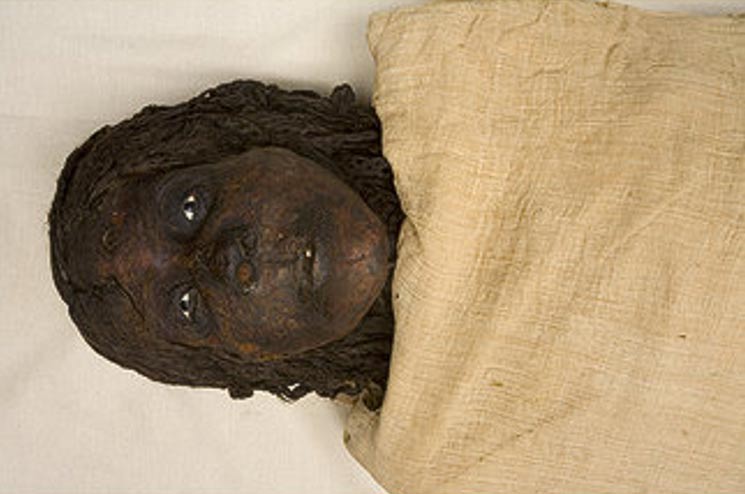
The Discovery of Nedjmet and the Secret Cache of Mummies
The mummy of Nedjmet (or Nodjmet) was one of the mummies found in the Deir el-Bahri mummy cache, which was discovered during the 19 th century. In the 1880s, the location of a hidden tomb was revealed to Egyptian authorities.
According to the informer, Mohammed el-Rasul, a goat belonging to his brother, Ahmed, had strayed away from its herd several years ago. When Ahmed went looking for his goat, he found that the animal had fallen down into a vertical hole on the cliff. Ahmed descended into the hole, and found himself in a narrow corridor cluttered with objects. After lighting a candle, he realized that the objects were ancient wooden coffins, stretching as far as he could see, and heaped one on top of the other.
The Protective Reburials of Royal Mummies
In addition to Nedjmet, the mummies of various New Kingdom pharaohs, including Thutmose III, Seti I and Ramesses II were also discovered. On the bandages of the mummy of Ramesses II, this inscription was found:
"Year 15, 3rd month of Akhet, Day 6: Day of bringing the Osiris king Usermaatre-setepenre (Ramesses II), Life! Prosperity! And Health!, to renew him and to bury him in the tomb of the Osiris king Menmaatre-Seti (I) Life! Prosperity! Health! By the high priest of Pinudjem."

The mummy of Ramesses II, Cairo, Egypt (Wikimedia Commons)
The re-internment of Ramesses II in the tomb of Seti I, however, was only the first in a series of reburials, as ever safer resting places were sought for these royal mummies. The deliberate reburial of mummies from tombs in the Valley of the Kings was undertaken by priests during the 21 st Dynasty, today regarded as part of the Third Intermediate Period. Due to looting in the Valley of the Kings, the priests resolved to rebury the mummies in secret caches, so as to prevent further desecration.
- The Life and Death of Ramesses II
- Archaeologists unearth tomb of Queen at the Mortuary Temple of Ramesses II
- The Liber Linteus: An Egyptian Mummy Wrapped in a Mysterious Message
- Egyptian Child Mummy Dumped in Garbage in France, Now Restored and Protected
Nedjmet and her Missing Husband Herihor
In addition to the New Kingdom pharaohs, priests of the 21 st Dynasty were also found in the Deir el-Bahri mummy cache. It is to this group of mummies that Nedjmet belonged. Nedjmet’s husband was Herihor, the High Priest of Amun during the reign of Ramesses XI, and de facto ruler of southern Egypt. Incidentally, Herihor was not found in the Dier el-Bahri mummy cache, and has yet been discovered.
Knowledge of Nedjmet’s relationship with Herihor, however, was derived from a papyrus from Nedjmet’s Book of the Dead, which may have been from the Deir el-Bahri mummy cache. This papyrus, now in the British Museum, depicts a scene where Nedjmet and Herihor are making offerings to Osiris, Isis and the four sons of Horus. Additionally, there is a scene where Nedjmet’s heart is being weighed, though instead of the conventional heart, a female figurine, that of Nedjmet perhaps, is shown.

Nedjmet and Herihor honoring the god Osiris in the afterlife, Book of the Dead papyrus of Nodjmet ( 1050 BC), British Museum, (Wikimedia Commons)
More Advanced Mummification
One of the important aspects of the mummy of Nedjmet is that it is a good example of the progress made in mummification techniques, at least concerning the appearance of the mummy.
In order to give Nedjmet’s mummy a more life-like appearance for instance, artificial eyes made of black and white stones, were placed under her eyelids. This technique is said to have only began in a later part of the history of mummification.
Moreover, sawdust was packed between the bandages of Nedjmet’s mummy so as to provide it with a volume comparable to that during life. To give the mummy a more lively appearance, her body and parts of her face were also colored.
Although it has been shown that Nedjmet was a relatively old woman at the time of her death, efforts were made by the embalmers to make her mummy appear youthful. For instance, Nedjmet’s mummy was provided with false eyebrows made of human hair. On top of that, a wig was also placed on the mummy’s head in order to cover up the onset of baldness.

Mummy of Nedjmet (Eternal Egypt)
The Positive Side of the Third Intermediate Period
Whilst the Third Intermediate Period (as well as the other two preceding intermediate periods) is commonly regarded as a period when the ancient Egyptian civilization was in decline, it was perhaps not all doom and gloom.
It was during this period that priests carried out the systematic reburial of royal mummies from the Valley of the Kings, thus saving them from the clutches of ancient grave robbers, and ensuring their survival till today. Moreover, mummification techniques during this period made some progress, a sign that despite about in the afterlife as their predecessors had been before them.
Top image: The Mummy of Nedjmet, Cairo, Egypt (Wikimedia Commons)
By Ḏḥwty
References
Françoise Dunand, R. L., 2006. Mummies and Death in Egypt. New York: Cornell University Press.
Lucas, A. & Harris, J. R., 1999. Ancient Egyptian Materials and Industries. New York: Dover Publications.
Parsons, M., 2011. Egypt: Royal Caches at Deir el-Bahri. [Online]
Available at: http://www.touregypt.net/featurestories/cache.htm
Taylor, J., 2002. The Third Intermediate Period (1069-664 BC). In: I. Shaw, ed. The Oxford History of Ancient Egypt. Oxford: Oxford University Press, pp. 330-368.
The British Museum, 2015. Papyrus from the Book of the Dead of Nedjmet. [Online]
Available at: http://www.britishmuseum.org/explore/highlights/highlight_objects/aes/p/papyrus_from_the_book_of_the-8.aspx
www.eternalegypt.org, 2015. Mummy of Queen Nedjmet. [Online]
Available at: http://www.eternalegypt.org/EternalEgyptWebsiteWeb/HomeServlet?ee_website_action_key=action.display.element&story_id=&module_id=&language_id=1&element_id=66099&text=text















Comments
what does the hieroglyph directly above Nedjmets head mean ? or say..
Black round field with white design inside.
Also was it really 'sawdust' packed inside her ? to puff her skin out.
how did they make 'sawdust' ? curious.
Anyone ?
This story helps strongly confirm that, Nefertiti's inside that hidden chamber of Tutankhamuns tomb.
She was reburied, more than anything else, to help protect her, as by those priests who felt Very strongly that by Tuankhamuns extreme popularity and youthful, unexpected, hurried burial, that she would be left alone as well..
How's that ? :) I bet Much, this theory has merit ! Can't wait when they open that hidden chamber.
Egyptian History is really fascinating .
Additionally, the saw dust is what has turned black on her.
Obviously, since the authentic painting depicts her with white skin ! And the Egyptians would have painted her with black skin IF she had that, But here is definate proof, SHE DOES NOT !
thanks for waking up, Finally, many of us hope you have.. Egyptians are not into inaccuracy in their, such great detailed paintings..
Pages